我前两天买了本MATLAB信号处理,但是很无语,感觉自己对MATLAB的语法很陌生,看了半天也觉得自己写不出来,所以就对着MATLAB自己去写用Python进行的数字信号处理基础,我写了两天左右,基本上把matlab书上的代码全部用Python实现了,所以,今天贴的代码和图有些多,
要用到的包:
1、Scipy包:其中signal库,这个库是真的绝,很多信号处理的基础函数都有的,
2、numpy包:numpy包中也有很多进行信号处理的,比如说相关、卷积,都有相关函数
3、mmatplotlib包:这就不多说了,信号处理就是用它来展示的,这里主要用到的就是stem方法。
signal库我找了一下,csdn有个博主总结的很全,这是他的博客链接,可以看一看:
(1条消息) scipy.signal信号处理的库(笔记06)_scipy.signalku_月疯的博客-CSDN博客
然后,还可以看一下scipy官方的文档,里面也有很详细的介绍:
Signal processing (scipy.signal) — SciPy v1.10.1 Manual
这里我做了个目录,可以查看相应的方法:
目录
1、离散时间信号序列的表示:
2、采样定理:
3、简单离散信号序列:
4、单位阶跃函数:
5、正弦信号序列:
6、实指数序列:
7、复指数序列:
8、序列值累加和乘积:
9、序列反转、移位:
10、信号的尺度变换:
11、连续信号的奇偶分解:
12、奇函数和偶函数合并:
13、信号的微积分:
14、积分:
15、卷积运算和相关计算
16、产生信号波形:
17、连续矩形周期信号采样变成离散信号:
18、随机函数,这个用numpy就可以直接生成:
19、三角波,用signal的sawtooth:
20、sinc曲线:
21、生成非周期三角波
22、高斯脉冲的实现:
23、脉冲序列发生器:
24、产生非周期方波:
25、连续时间信号的时域分析
(1)零状态响应:
(2)冲激响应和阶跃响应:
(3)各种信号的响应:
(4)连续时间信号的卷积:
26、离散时间系统:
27、离散时间系统的冲激和阶跃响应:
28、卷积和运算,这都不用说啥了,前面都说过了:
29、相关序列(自相关、互相关):
1、离散时间信号序列的表示:
import matplotlib.pyplot as plt
import numpy as np
from scipy import signal
N=np.linspace(-3,11,15,dtype=int)
x=np.array([0,2,3,3,2,3,0,-1,-2,-3,-4,-5,1,2,1])
dt=0.01
n=N*dt
fig=plt.figure()
ax1=fig.add_subplot(2,1,1)
ax1.stem(N,x)
ax2=fig.add_subplot(2,1,2)
ax2.plot(n,x)
ax2.plot(n,np.zeros(len(n)))
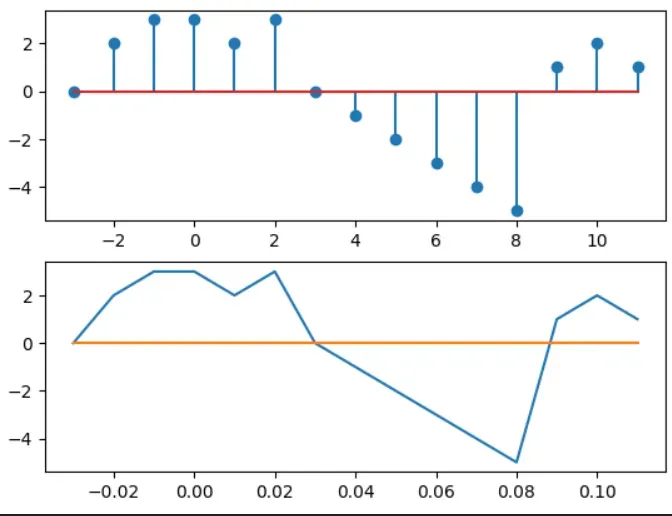
2、采样定理:
#用10hz的采样频率采样
import matplotlib.pyplot as plt
import numpy as np
from scipy import signal
dt=0.01
n=np.linspace(0,89,90,dtype=int)
t=n*dt
f=10
x=np.sin(3*np.pi*f*t+0.5)#原始信号
dt=0.1
n=np.linspace(0,9,10,dtype=int)
t1=n*dt
x1=np.sin(3*f*np.pi*t1+0.5)# 采样后的信号
fig1=plt.figure()
ax1=fig1.add_subplot(3,1,1)
ax1.plot(t,x)
ax1.set_title('origional signal')
ax2=fig1.add_subplot(3,1,2)
ax2.plot(t,x)
ax2.plot(t1,x1,'*')
ax2.set_title('Sampling process')
ax3=fig1.add_subplot(3,1,3)
ax3.plot(t1,x1)
ax3.set_title('Sampling signal')
plt.show()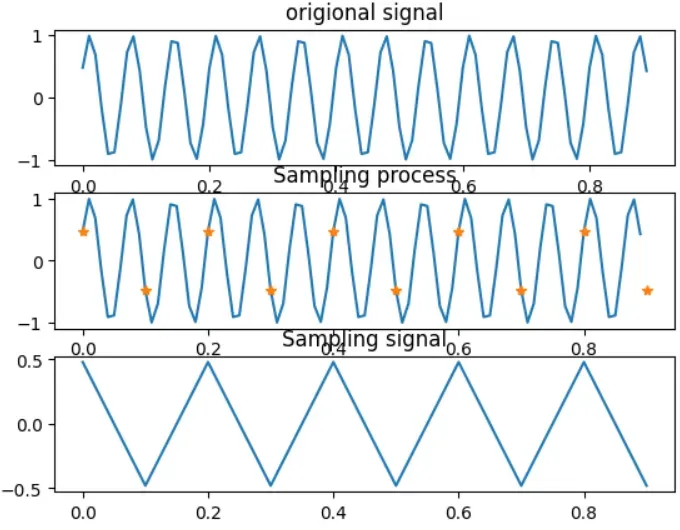
3、简单离散信号序列:
import matplotlib.pyplot as plt
import numpy as np
from scipy import signal
n=50
x=np.zeros(n)
x[1]=1
xn=np.linspace(0,n-1,n,dtype=int)
fig1=plt.figure()
ax1=fig1.add_subplot(2,1,1)
ax1.stem(xn,x)
x[1]=0
x[10]=1
ax2=fig1.add_subplot(2,1,2)
ax2.stem(xn,x)
plt.show()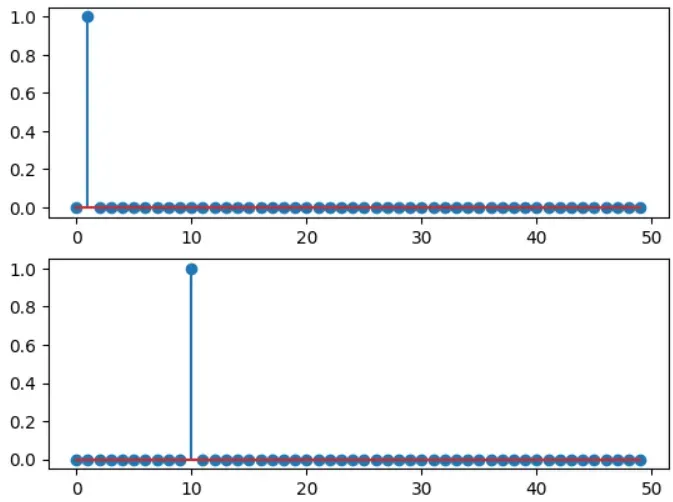
4、单位阶跃函数:
这个我没有在signal里找到,但是我自己写了一个:
import matplotlib.pyplot as plt
import numpy as np
from scipy import signal
def u(n):
if n>=0:
r=1
else:
r=0
return r
x=np.linspace(-10,10,21,dtype=int)
y=np.array([u(i)for i in x])
plt.stem(x,y)
plt.show()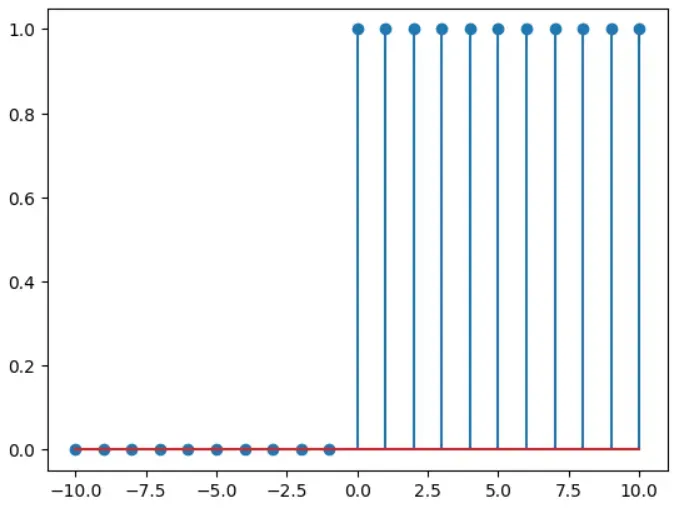
很简单的,最简单的是递增序列,就是一个递增函数就行,比如说上面的x,他就是个递增序列:
plt.stem(x,x,'r')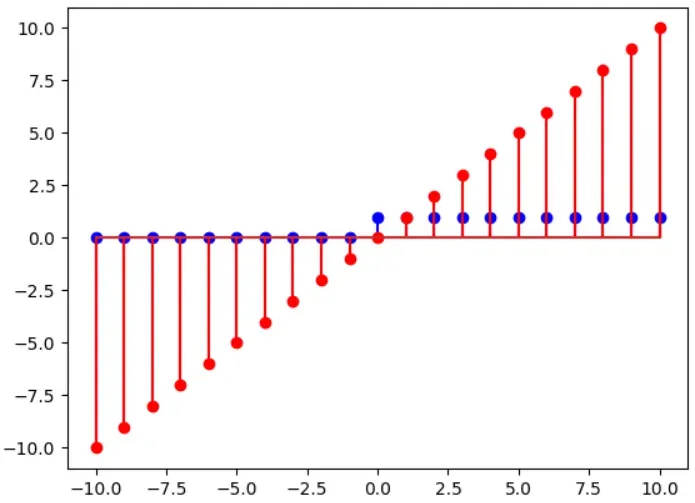
蓝色的就是刚才的阶跃序列,
5、正弦信号序列:
这个也很简单,延续上面的代码:
# x=np.linspace(-10,10,21,dtype=int)
# z=np.linspace(-10,10,10000,dtype=float)
plt.stem(x,np.sin(x))
plt.plot(z,np.sin(z),'r')
plt.show()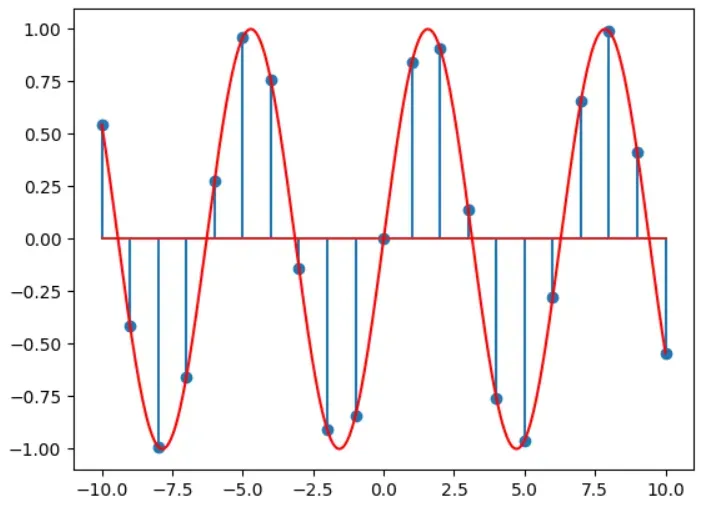
可以看到,红色的连续信号和蓝色棉签棒的离散信号。
6、实指数序列:
numpy的power函数可以很简单的实现:
import matplotlib.pyplot as plt
import numpy as np
from scipy import signal
import sympy as sy
n=np.linspace(-10,10,21,dtype=int)
y1=np.power(1.6,n)
y2=np.power(-1.6,n)
y3=np.power(0.9,n)
y4=np.power(-0.9,n)
f=plt.figure()
ax1=f.add_subplot(2,2,1)
ax1.stem(n,y1)
ax2=f.add_subplot(2,2,2)
ax2.stem(n,y2)
ax3=f.add_subplot(2,2,3)
ax3.stem(n,y3)
ax4=f.add_subplot(2,2,4)
ax4.stem(n,y4)
ax1.set_title('1.6^n')
ax2.set_title('(-1.6)^n')
ax3.set_title('0.9^n')
ax4.set_title('(-0.9)^n')
plt.show()
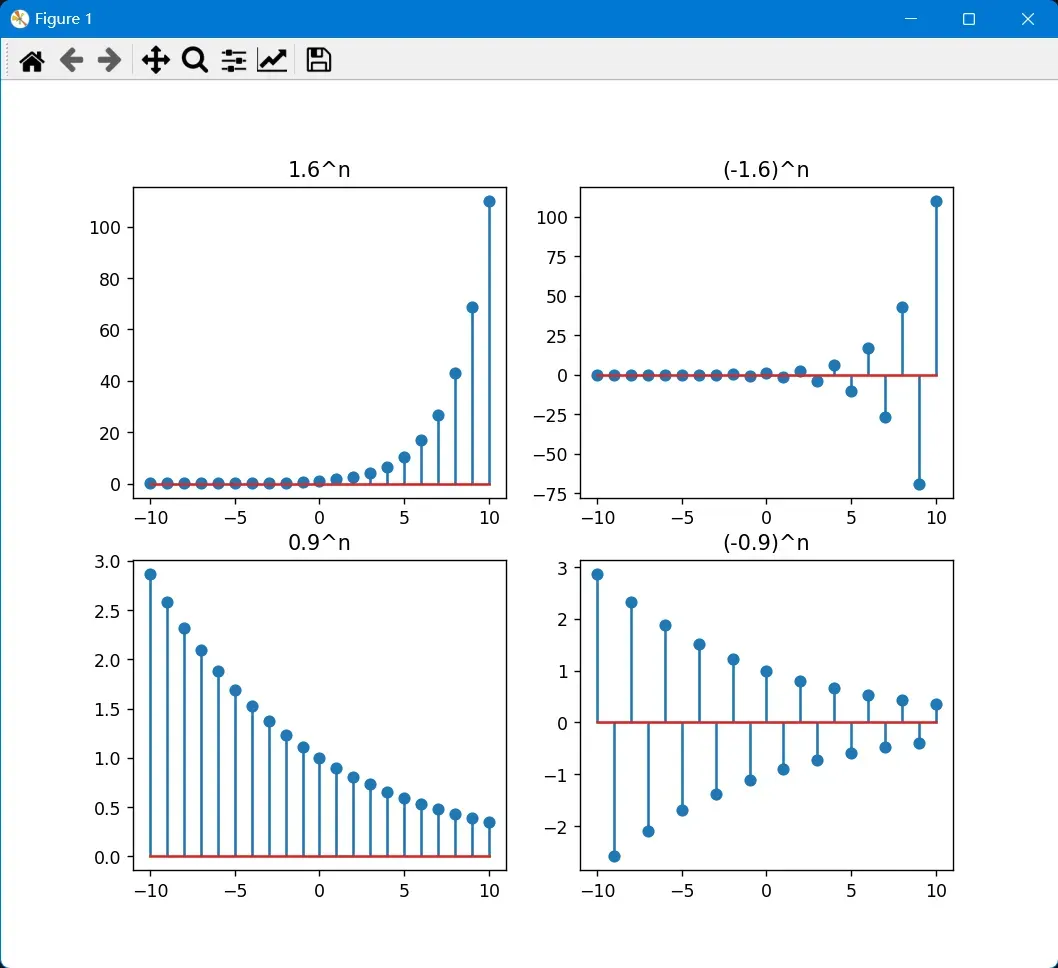
7、复指数序列:
import matplotlib.pyplot as plt
import numpy as np
from scipy import signal
import cmath
n=np.linspace(0,50,51,dtype=complex)
A=3
a=-1/9
b=np.pi/5
h=-1/9+np.pi/5j
x=A*np.exp(h*n)
f=plt.figure()
ax1=f.add_subplot(2,2,1)
ax1.stem(n,x.real)
ax2=f.add_subplot(2,2,2)
ax2.stem(n,x.imag)
ax3=f.add_subplot(2,2,3)
ax3.stem(n,abs(x))
ax4=f.add_subplot(2,2,4)
y=np.array([-cmath.phase(i) for i in x])#如果直接用phase的话,和matlab计算的angle是相反的,所以我这里为了和matlab一样,就用了-phase
ax4.stem(n,y)
ax1.set_title('real')
ax2.set_title('imag')
ax3.set_title('abs')
ax4.set_title('angle')
plt.show()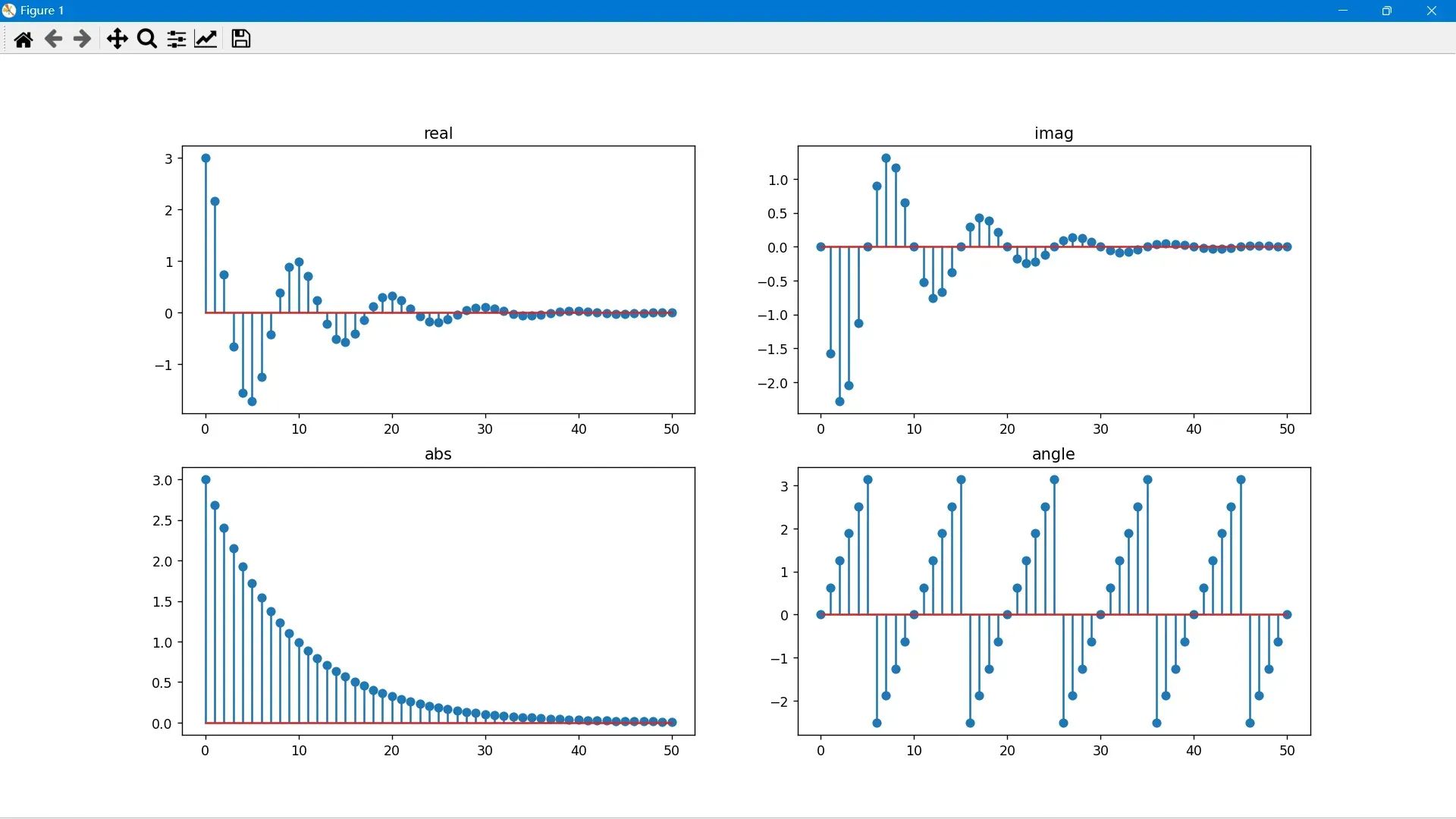
8、序列值累加和乘积:
这个就是常规的numpy操作,没啥意思
9、序列反转、移位:
反转的话,可以用[::-1]或者也可以用y=np.flipud(x),两者是一样的效果,信号移位就是,在一个信号序列前面或者后面加一个全零数组,前面加就是延迟,后面加就是提前:
# matlab中有一个函数较fliplr(x)来进行序列反转,但是,python会比这个更简单:两种方法:第一种是用列表反转的形式,第二种是用numpy的flipud函数执行
import numpy as np
import matplotlib.pyplot as plt
nx=np.linspace(-2,5,8,dtype=int)
x=np.linspace(2,9,8,dtype=int)
ny=-np.flipud(nx)
y=np.flipud(x)
print(ny)
print(y)
# ny=-nx[::-1]
# y=x[::-1]
fig=plt.figure()
ax1=fig.add_subplot(2,1,1)
ax1.stem(nx,x,'.')
ax1.axis([-6,6,-1,9])
ax1.grid(visible=True)
ax1.set_xlabel('n')
ax1.set_ylabel('x(n)')
ax1.set_title('origional sequence')
ax2=fig.add_subplot(2,1,2)
ax2.stem(ny,y,'.')
ax2.axis([-6,6,-1,9])
ax2.grid(visible=True)
ax2.set_xlabel('n')
ax2.set_ylabel('y(n)')
ax2.set_title('Inversion sequence')
plt.show()
#序列位移:
import matplotlib.pyplot as plt
import numpy as np
nx=np.linspace(-2,5,8,dtype=int)
x=np.array([9,8,7,6,5,5,5,5])
y=x
ny1=nx+3
ny2=nx-2
fig=plt.figure()
ax1=fig.add_subplot(2,1,1)
ax1.stem(nx,x,'.')
ax1.axis([-5,9,-1,10])
ax1.grid(visible=True)
ax1.set_xlabel('n')
ax1.set_ylabel('x(n)')
ax1.set_title('origional sequence')
ax2=fig.add_subplot(2,2,3)
ax2.stem(ny1,y,'.')
ax2.axis([-5,9,-1,10])
ax2.grid(visible=True)
ax2.set_xlabel('n')
ax2.set_ylabel('y1(n)')
ax2.set_title('y1=(n+3)')
ax3=fig.add_subplot(2,2,4)
ax3.stem(ny2,y,'.')
ax3.axis([-5,9,-1,10])
ax3.grid(visible=True)
ax3.set_xlabel('n')
ax3.set_ylabel('y2(n)')
ax3.set_title('y2=(n-2)')
plt.show()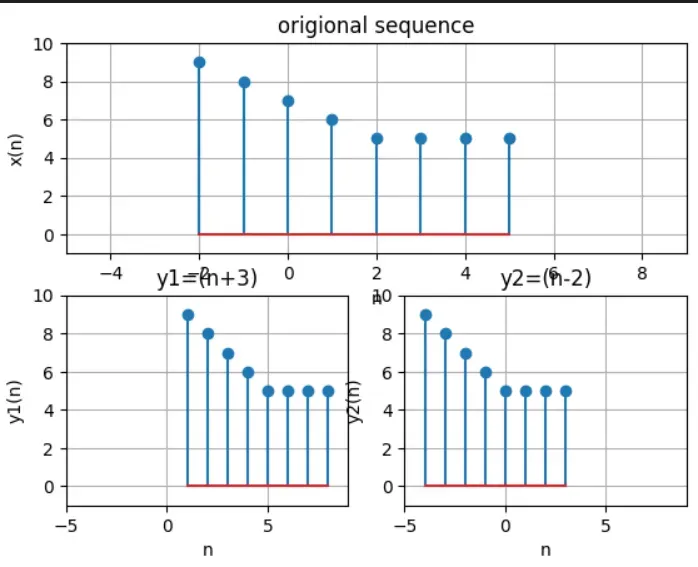
10、信号的尺度变换:
把信号的横坐标压缩或者扩展:
t = np.linspace(-4, 4, 8000, dtype=float)
T = 2
f = np.zeros((8000),dtype=float)
t1=2*t
f1=np.zeros((8000),dtype=float)
for i in range(len(t)):
if ((-1 <= t[i]) & (t[i] <= 1)).any():
f[i] = 1
for i in range(len(t1)):
if ((-0.5 <= t1[i]) & (t1[i] <= 0.5)).any():
f1[i] = 1
fig=plt.figure()
ax1=fig.add_subplot(2,1,1)
ax1.plot(t,f)
ax1.axis([-4,4,-0.5,1.5])
ax2=fig.add_subplot(2,1,2)
ax2.plot(t1,f1)
ax2.axis([-4,4,-0.5,1.5])
plt.show()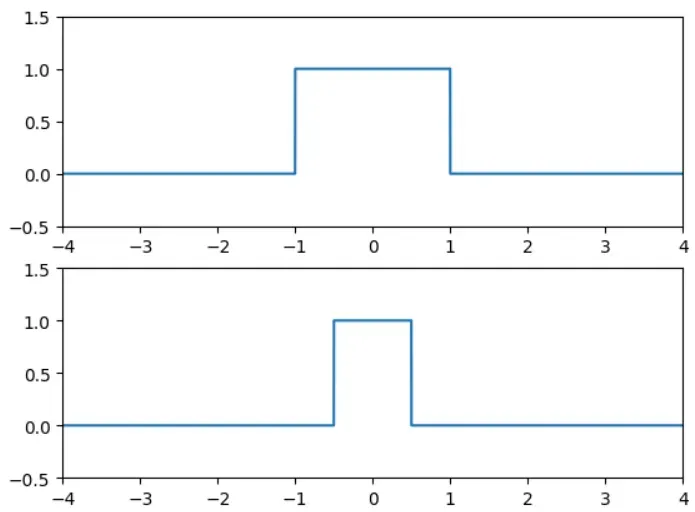
11、连续信号的奇偶分解:
我们都知道,一个信号可以分解成一个偶分量和一个奇分量:
#连续信号的奇偶分解:
#对于一个信号f(n)来说,奇信号:1/2[f(t)-f(-t)]偶信号:1/2[f(t)+f(-t)]
t=np.linspace(-8,8,100000)
f=np.cos(t+1)+t
f1=np.cos(-t+1)-t
g=1/2*(f+f1)
h=1/2*(f-f1)
fig=plt.figure()
ax1=fig.add_subplot(3,1,1)
ax1.plot(t,f)
ax1.set_title('origional signal')
ax2=fig.add_subplot(3,1,2)
ax2.plot(t,g)
ax2.set_title('odd signal')
ax3=fig.add_subplot(3,1,3)
ax3.plot(t,h)
ax3.set_title('even signal')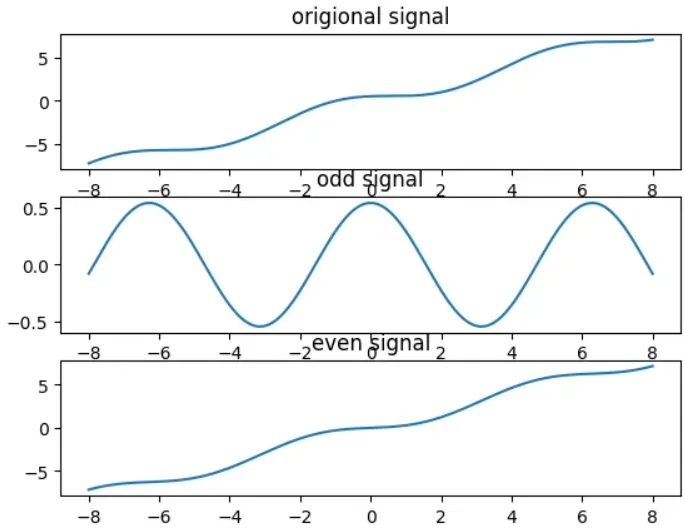
12、奇函数和偶函数合并:
还是上面的
#将上面的两个奇偶分量合并成原函数:就是反向操作一波,也可以用g-h
t=np.linspace(-8,8,100000)
f=np.cos(t+1)+t
f1=np.cos(-t+1)-t
g=1/2*(f+f1)
h=1/2*(f-f1)
z=g+h
l=h-g
fig=plt.figure()
ax1=fig.add_subplot(4,1,3)
ax1.plot(t,z)
ax1.set_title('origional signal')
ax1=fig.add_subplot(4,1,4)
ax1.plot(t,l)
ax1.set_title('origional signal')
ax2=fig.add_subplot(4,1,1)
ax2.plot(t,g)
ax2.set_title('odd signal')
ax3=fig.add_subplot(4,1,2)
ax3.plot(t,h)
ax3.set_title('even signal')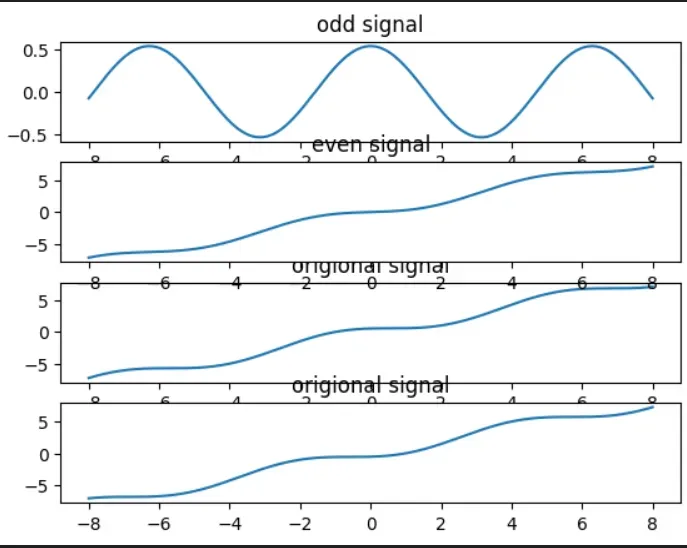
多画了一个原函数,将就着看吧
13、信号的微积分:
这个里面有一个heaviside函数,matlab有,但是python没有,然后我就把它自己实现了,要用的可以直接用:
import matplotlib.pyplot as plt
import numpy as np
import sympy as sp
from scipy import signal
import sympy.plotting as syp
def heaviside(x):
if x==0:
r=0.5
elif x>0:
r=1
elif x<0:
r=0
return r
#本来要用的,但我们没有用heaviside函数
t=sp.symbols('t')
f=sp.Function('f')(t)
f=t*t+2*t-1
f1=f.diff(t)#一阶导
f2=f.diff(t,t)#二阶导
f3=f.diff(t,t,t)#三阶导
syp.plot(f,f1,f2,f3,(t,-1,2))
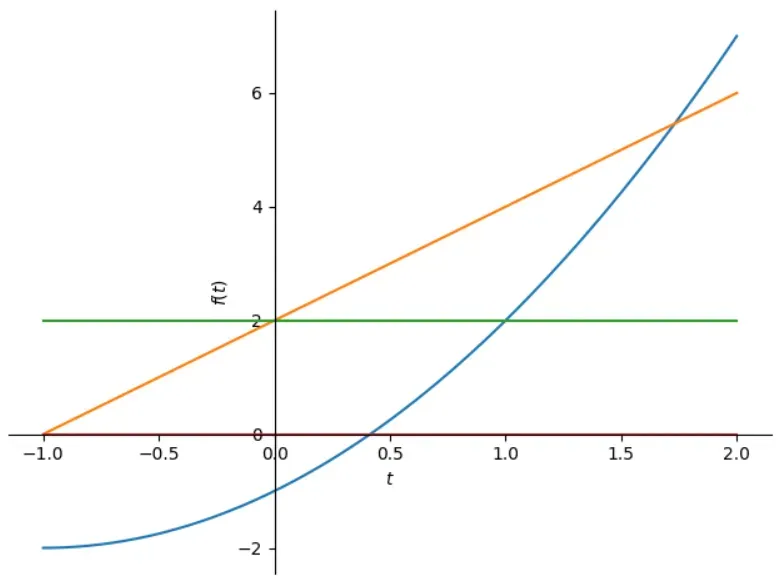
14、积分:
这里用的是:
import sympy as sy
t,f=sy.symbols('t,f')
f=2*t+2
intt=sy.integrate(f,t)
print(intt)
syp.plot(intt,(t,-7,5))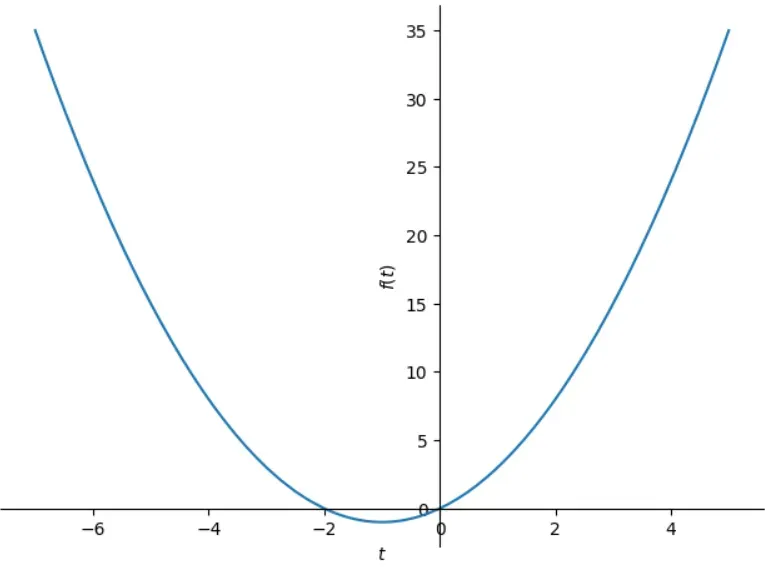
当然,微积分这里比较水,以为找个很好看的函数很麻烦
15、卷积运算和相关计算
连续信号和离散信号都一样,我们可以用numpy中的convolve函数,singal中也有这个函数,直接计算就可以,这里给例子:
#离散时间信号的卷积和运算
import matplotlib.pyplot as plt
import numpy as np
from scipy import signal
def uDt(n):
if n>=0:
y=1
else:
y=0
return y
nx=np.linspace(-1,5,7,dtype=int,endpoint=True)
nh=np.linspace(-2,10,13,dtype=int,endpoint=True)
nx2=nx-4
nh2=nh-9
x=np.array([uDt(i)for i in nx])-np.array([uDt(i)for i in nx2])
h=np.power(0.9,nh)
h1=np.array([uDt(i)for i in nh])-np.array([uDt(i)for i in nh2])
y=np.convolve(h,h1)
ny1=nx[0]+nh[0]
ny=ny1+np.linspace(0,(len(y)),len(y),dtype=int)
fig=plt.figure()
ax1=fig.add_subplot(3,1,1)
ax1.stem(nx,x)
ax1.grid(visible=True)
ax1.set_title('x(n)')
ax1.axis([-4,16,0,1.5])
ax2=fig.add_subplot(3,1,2)
ax2.stem(nh,h)
ax2.grid(visible=True)
ax2.set_title('h(n))')
ax2.axis([-4,16,0,1.5])
ax3=fig.add_subplot(3,1,3)
ax3.stem(ny,y)
ax3.set_title('y(n)')
ax3.grid(visible=True)
ax3.axis([-4,16,0,9])
plt.show()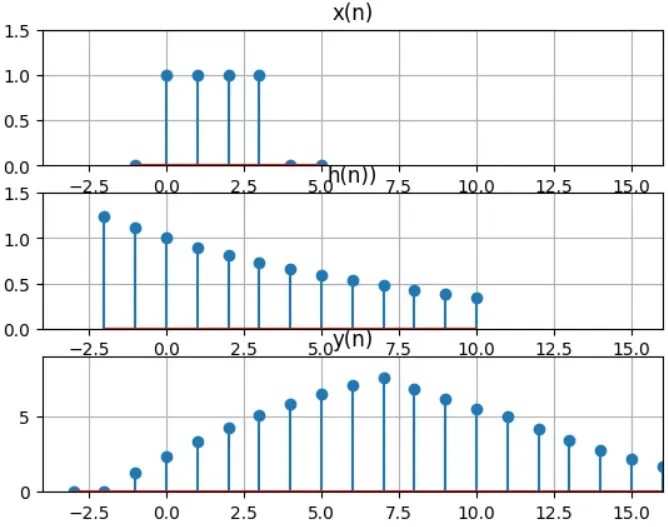
然后相关序列计算,切记,千万不要和person系数混淆了,我先用person那个函数计算来着,后来发现是不对的,signal.correlate和np.correlate都可以完成相关计算:
#计算自相关和互相关
import matplotlib.pyplot as plt
import numpy as np
from scipy import signal
from scipy.stats import pearsonr
x=np.array([1,3,5,7,9,11,13,15,17,19])
y=np.array([1,1,1,1,2,2,2,2,2,2])
# 计算自相关函数
auto_corr = signal.correlate(x, x, mode='same')
# 计算互相关函数
cross_corr = signal.correlate(x, y, mode='same')
# np.correlate
print("自相关函数:", auto_corr)
print("互相关函数:", cross_corr)这里就不放图了,没啥意思,就两个类似山峰的曲线,
16、产生信号波形:
from scipy import signal as signal
t=np.linspace(0,1,200,dtype=float)
# scipy.signal.chirp(t, f0, t1, f1, method='linear', phi=0, vertex_zero=True)
h=signal.chirp(t,0,1,120,method='linear',phi=np.pi/3)#linear线性\quadratic二次扫描、logarithmic对数扫描(这时候f0、f1均不能为零)
plt.plot(t,h)
plt.grid(visible=True)
plt.show()我们这里用singal的chirp函数来生成波形,这里,产生的波形是时间轴为t,时刻0的瞬间频率是f0,时刻t1的瞬间频率是f1,method就是你可以产生波形的方法,phi就是相位,一般来说vertex_zero设置成缺省值就行。
来看一下:
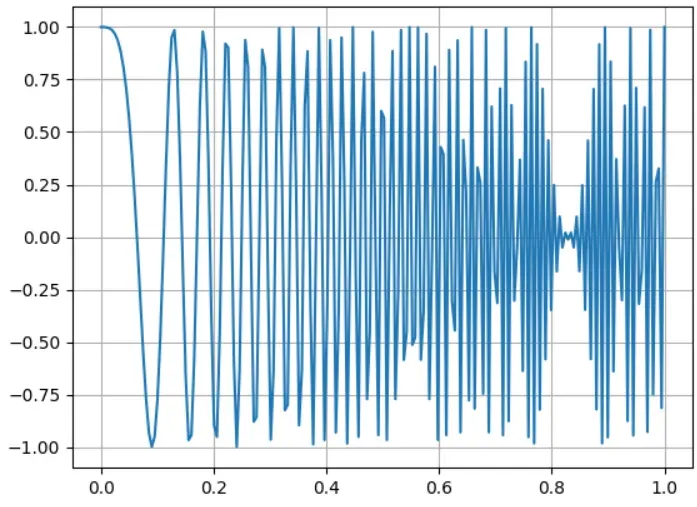
17、连续矩形周期信号采样变成离散信号:
import matplotlib.pyplot as plt
import numpy as np
from scipy import signal
f=6000
nt=3
N=15
T=1/f
dt=T/N
n=np.linspace(0,50,51,dtype=int)
tn=n*dt
x=signal.square(2*f*np.pi*tn,duty=0.25)+1
fig=plt.figure()
ax1=fig.add_subplot(2,1,1)
ax1.step(tn,x,'k')
ax1.axis([0,nt*T,1.2*min(x),1.1*max(x)])
ax1.set_ylabel('x(t)')
ax2=fig.add_subplot(2,1,2)
ax2.stem(tn,x,'r')
ax2.axis([0,nt*T,1.2*min(x),1.1*max(x)])
ax2.set_ylabel('x(n)')
plt.show()
18、随机函数,这个用numpy就可以直接生成:
#生成随机函数:
t=np.linspace(0,49,dtype=int)
N=len(t)
x=np.random.random(len(t))
fig2=plt.figure()
ax1=fig2.add_subplot(2,1,1)
ax1.plot(t,x)
ax1.set_xlabel('n')
ax1.set_ylabel('x(n)')
ax2=fig2.add_subplot(2,1,2)
ax2.stem(t,x)
ax2.set_xlabel('n')
ax2.set_ylabel('x(n)')
plt.show()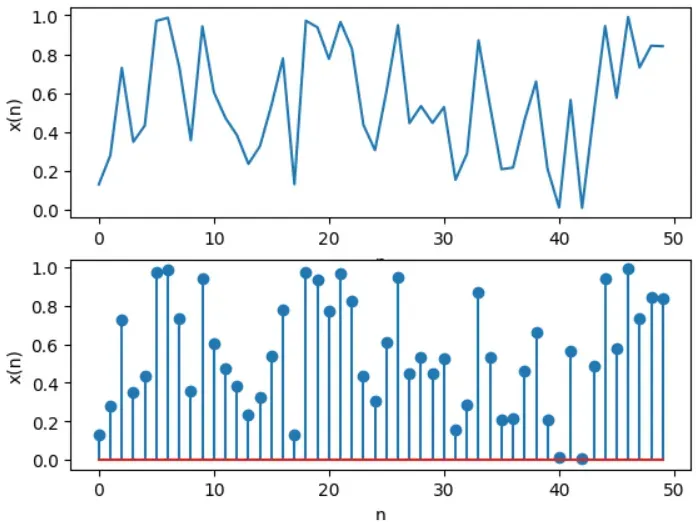
19、三角波,用signal的sawtooth:
#生成三角波
fs=10000
t=np.linspace(0,1,fs,dtype=float)
x1=signal.sawtooth(1*np.pi*40*t,0)
x2=signal.sawtooth(1*np.pi*40*t,1)
fig3=plt.figure()
ax1=fig3.add_subplot(2,1,1)
ax1.plot(t,x1)
ax1.set_xlabel('n')
ax1.set_ylabel('x(n)')
ax1.axis([0,0.25,-1,1])
ax2=fig3.add_subplot(2,1,2)
ax2.plot(t,x2)
ax2.set_xlabel('n')
ax2.set_ylabel('x(n)')
ax2.axis([0,0.25,-1,1])
plt.show()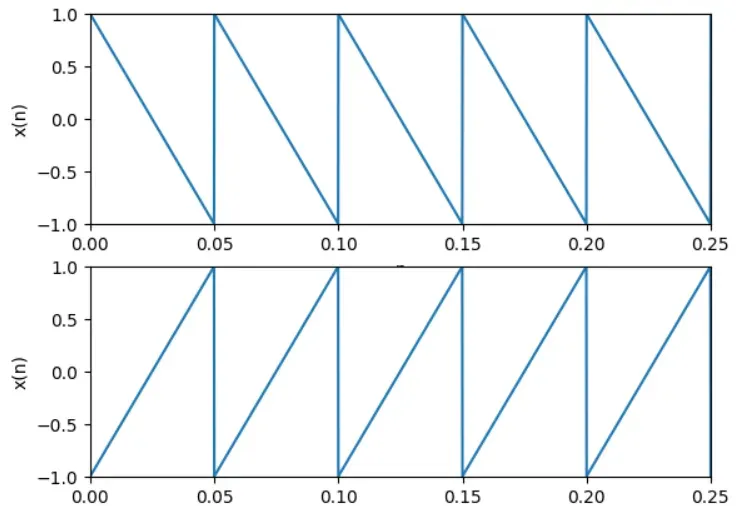
20、sinc曲线:
t=np.linspace(-3*np.pi,4*np.pi,400,dtype=float)
plt.plot(t,np.sinc(t))
plt.show()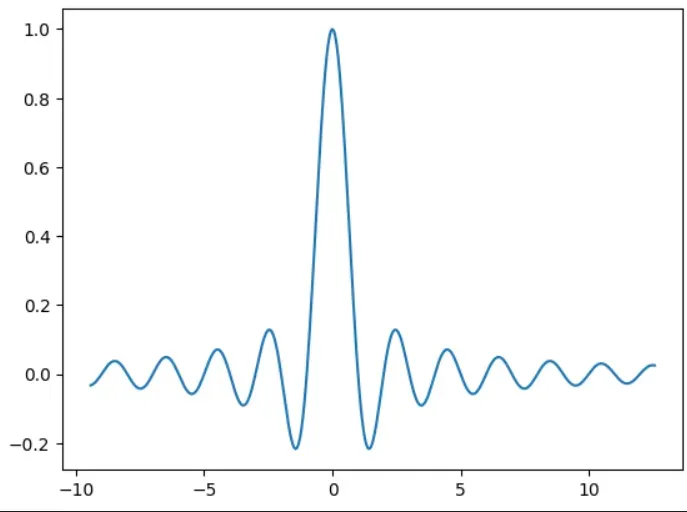
但是,有一点我到现在还没想通,同样的sinc,用公式推到的和内置的,出来的效果就是不一样:
t=np.linspace(-10,10,10000,dtype=float)
x=np.random.randint(len(t))
y=np.sinc(t)
y1=np.sin(t)
# y2=np.divide(y1,t)
y2=y1/t
fig3=plt.figure()
ax1=fig3.add_subplot(3,1,1)
ax1.plot(t,y)
ax2=fig3.add_subplot(3,1,2)
ax2.plot(t,y1)
ax3=fig3.add_subplot(3,1,3)
ax3.plot(t,y2)
ax3.plot(t,y,'r*')
plt.show()
#好奇怪啊,为什么,已知的是sinc(t)=sin(t)/t,但是我用这种方法做出来的,两个信号的宽度不一样
from mayavi import mlab
from mpl_toolkits.mplot3d import Axes3D
fig=plt.figure()
z=np.linspace(-10,2500,10000,dtype=float).reshape(100,100)
ax=fig.add_subplot(1,1,1, projection='3d')
t2=t.reshape(100,100)
x2=np.sinc(t2)
ax.plot_surface(t2,x2,z,rstride=4,cstride=3,color='r',alpha=0.9)
三维的我会展示另一幅,以为上面这个代码中的三维太难看了,
import numpy as np
import matplotlib.pyplot as plt
from mpl_toolkits.mplot3d import Axes3D
# 生成数据
x = y = np.linspace(-10, 10, 100)
X, Y = np.meshgrid(x, y)
R = np.sqrt(X**2 + Y**2)
# Z = np.sin(R) / R
z=np.sinc(R)
# 绘制图像
fig = plt.figure()
ax = fig.add_subplot(111, projection='3d')
ax.plot_surface(X, Y, z, cmap='coolwarm')
plt.show()
就这样吧
21、生成非周期三角波
这个利用自己写的函数生成一个就好:
#非周期三角波信号:
t=np.linspace(-2,2,4000)
def triangle_wave(x,c,hc): #幅度为hc,宽度为c,斜度为hc/2c的三角波
if x>=c/2:
r=0.0
elif x<=-c/2:
r=0.0
elif((x>-c/2)and(x<0)):
r=2*x/c*hc+hc
else:
r=-2*x/c*hc+hc
return r
x=np.array([triangle_wave(i,0.5,0.5) for i in t ])
plt.plot(t,x)
plt.show()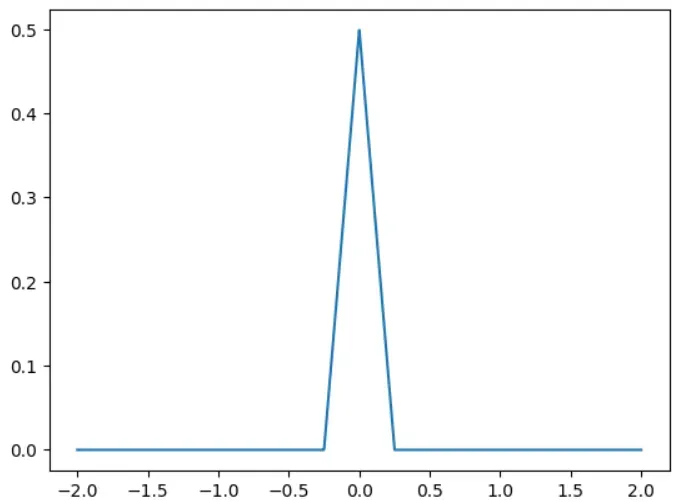
22、高斯脉冲的实现:
#高斯正弦脉冲:signal.gausspulse(t, fc=1000, bw=0.5, bwr=-6, tpr=-60, retquad=False,retenv=False):
tc=signal.gausspulse('cutoff',60e3,0.6,tpr=-40)
tG=np.linspace(-tc,tc,100000)
y=signal.gausspulse(tG,60e3,0.6)
plt.plot(tG,y)
plt.show()
23、脉冲序列发生器:
这个就是上面的square函数和sawtooth:
import matplotlib.pyplot as plt
import numpy as np
from scipy import signal
n=np.linspace(0,10,dtype=float)
h=signal.square(1*np.pi*40*n)
z=signal.sawtooth(1*np.pi*40*n)
fig=plt.figure()
ax1=fig.add_subplot(2,1,1)
ax1.plot(n,h)
ax1.set_title('square')
ax2=fig.add_subplot(2,1,2)
ax2.plot(n,z)
ax2.set_title('sawtooth')
plt.show()
24、产生非周期方波:
#产生非周期方波:matlab 中用的是rectpuls,python似乎还没有这个函数,但是可以自己实现,这是我复制的别人滴
def rect_wave(x,c,c0): #起点为c0,宽度为c的矩形波
if x>=(c+c0):
r=0.0
elif x<c0:
r=0.0
else:
r=1
return r
t=np.linspace(-3,3,6000)
y1=np.array([rect_wave(i,1.0,-2.0) for i in t])
plt.plot(t,y1)
plt.show()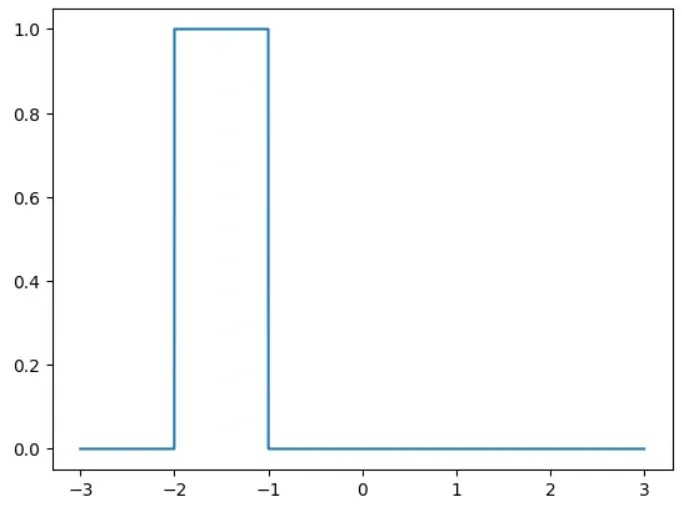
25、连续时间信号的时域分析
(注意,到这里就很注重系统的概念了)
就是求解齐次方程和非齐次方程求解零输入响应和零状态响应:
(1)零状态响应:
#连续时间系统数值求解:matlab有提供函数lsim,python中应该有:scipy包里面有lsim函数:def lsim(system, U, T, X0=None, interp=True):和matlab中的几乎一模一样
from scipy import signal as signal
ts=0
te=5
dt=0.01
# 计算系统的零状态响应,系统是:y''+2y'+100y=10cos(2*pi*t)
# 这里,第一项是右端系数,第二项是左端系数,实际上,lti官方文档给的示例是4个二维矩阵,但我没有明白他们是要干什么。
sys=signal.lti([1],[1,2,200])
t=np.linspace(ts,te,500)
f=10*np.cos(2*np.pi*t)
T,yout,xout=signal.lsim2(sys,f,t)
plt.plot(t,yout)
plt.show()
# 和matlab书上展示的一模一样,展示了该系统的零状态响应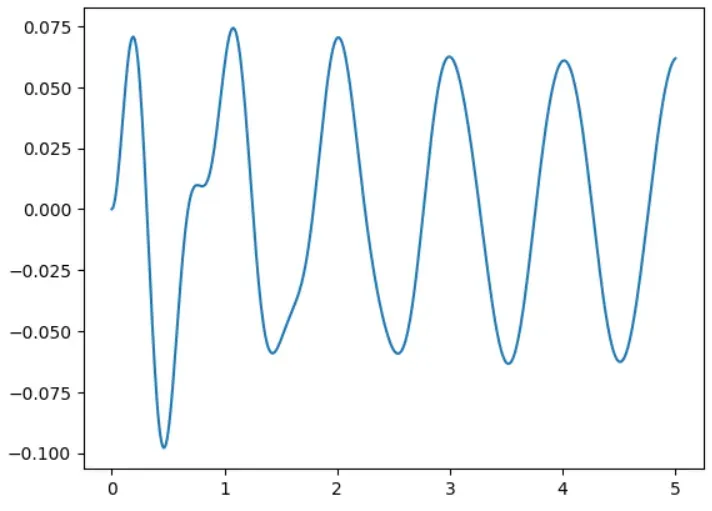
(2)冲激响应和阶跃响应:
# 连续时间系统系统冲击响应和节约响应:这个matlab有impuls和step,python也当然是有滴,就在singal里面:
import matplotlib.pyplot as plt
import numpy as np
from scipy import signal
t=np.linspace(0,4,2000)
system=([1,32],[1,4,64])
t,h=signal.impulse(system,T=t,N=2000)
t1,g=signal.step(system,T=t,N=2000)
fig1=plt.figure()
ax1=fig1.add_subplot(2,1,1)
ax1.plot(t,h)
ax1.set_xlabel("t")
ax1.set_ylabel('h(t)')
ax1.set_title('impulse')
ax1.grid(visible=True)
ax1.axis([0,4,-1.5,3])
ax2=fig1.add_subplot(2,1,2)
ax2.plot(t1,g)
ax2.set_xlabel("t")
ax2.set_ylabel('g(t)')
ax2.set_title('step')
ax2.grid(visible=True)
ax2.axis([0,4,0,1])
plt.show()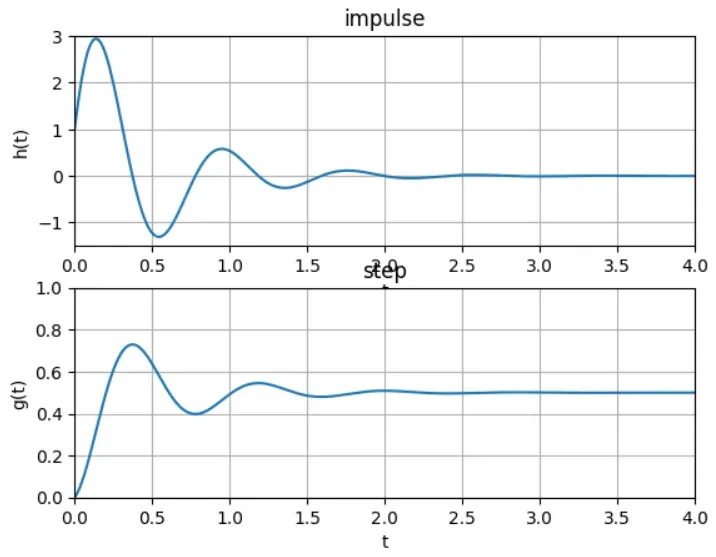
(3)各种信号的响应:
#计算一个特定系统:
import matplotlib.pyplot as plt
import numpy as np
from scipy import signal
b=[-0.46,-0.25,-0.12,-0.06]
a=[1,0.64,0.94,0.51,0.01]
system=(b,a)
t1=np.linspace(0,10,10000)
t2=np.linspace(-5,5,10000)
f1=np.zeros(len(t1))
def rect_wave(x,c,c0): #起点为c0,宽度为c的矩形波
if x>=(c+c0):
r=0.0
elif x<c0:
r=0.0
else:
r=1
return r
def heaviside(x):
if x==0:
r=0.5
elif x>0:
r=1
elif x<0:
r=0
return r
def unit(t):
r=np.where(t>0.0,1.0,0.0)
return r
f1=np.array([heaviside(i)for i in t1])-np.array([heaviside(i) for i in t1])
# f2=np.array([rect_wave(i,1,-1) for i in t2])
f2=np.ones(len(t1))
f2[10:11]=0
f3=t1
f4=np.sin(t1)
T1,yout1,xout1=signal.lsim2(system,f1,t1)
T2,yout2,xout2=signal.lsim2(system,f2,t1)
T3,yout3,xout3=signal.lsim2(system,f3,t1)
T4,yout4,xout4=signal.lsim2(system,f4,t1)
#f1、f2这两个有些问题
fig2=plt.figure()
ax1=fig2.add_subplot(2,2,1)
ax1.plot(t1,yout1)
ax1.set_title('chongji')
ax2=fig2.add_subplot(2,2,2)
ax2.plot(t1,yout2)
ax2.set_title('jump')
ax3=fig2.add_subplot(2,2,3)
ax3.plot(t1,yout3)
ax3.set_title('xiepo')
ax4=fig2.add_subplot(2,2,4)
ax4.plot(t1,yout4)
ax4.set_title('sin')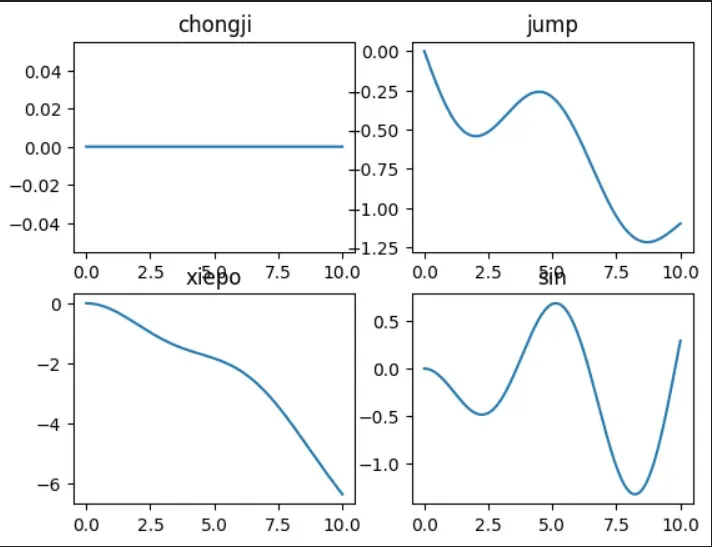
[0,0]这幅图有些问题,其他的都没啥问题。
(4)连续时间信号的卷积:
#连续时间信号卷积求解:
import matplotlib.pyplot as plt
import numpy as np
from scipy import signal
dt=0.01
t=np.linspace(-1,2.5,350)
t1=t-2
# matlab的heaviside函数是一个阶跃函数,当输入为0时返回0.5,当输入大于0时返回1,当输入小于0时返回0。它的定义是:
# heaviside(x) = 0.5, x = 0
# heaviside(x) = 1, x > 0
# heaviside(x) = 0, x < 0
def heaviside(x):
if x==0:
r=0.5
elif x>0:
r=1
elif x<0:
r=0
return r
def unit(t):
r=np.where(t>0.0,1.0,0.0)
return r
f1=np.array([heaviside(i)for i in t])-np.array([heaviside(i) for i in t1])*0.5
f2=2*np.exp(-3*t)*np.array([heaviside(i)for i in t])
f=np.convolve(f1,f2)*dt
n=len(f)
tt=np.linspace(0,n,n)*dt-2
fig3=plt.figure()
ax1=fig3.add_subplot(3,2,1)
ax1.plot(t,f1)
ax1.axis([-1,2.5,0,1.2])
ax1.set_title('f1(t)')
ax1.grid(visible=True)
ax2=fig3.add_subplot(3,2,2)
ax2.plot(t,f2)
ax2.axis([-1,2.5,0,2])
ax2.set_title('f2(t)')
ax2.grid(visible=True)
ax3=fig3.add_subplot(3,1,2)
ax3.plot(tt,f)
ax3.axis([-2,5,0,1])
ax3.set_title('convolve')
ax3.grid(visible=True)
f4=signal.convolve(f1,f2)*dt
ax4=fig3.add_subplot(3,1,3)
ax4.plot(tt,f4)
ax4.axis([-2,5,0,1])
ax4.set_title('convolve')
ax4.grid(visible=True)
plt.show()
这里第三张用的是numpy的卷积函数,第四张用的是signal的卷积函数,我就是想看看,两者有没有上面出入。
26、离散时间系统:
实现离散时间系统的实现连续时间系统是很简单的,用numpy就行,说白了,连续就是点很多,很密,就和微分一样,我分的越细,它逼近的就越好,离散也一样,你就认为在和连续时间信号两者范围相同的情况下,区区有限个点就行:
import matplotlib.pyplot as plt
import numpy as np
from scipy import signal
#离散
t=np.linspace(-10,10,41,dtype=float)
#连续
t1=np.linspace(-10,10,10000000,dtype=float)
x=signal.square(np.pi*2*t)
x1=signal.square(np.pi*2*t1)
fig=plt.figure()
ax1=fig.add_subplot(2,1,1)
ax1.stem(t,x)
ax1.set_title('discrete')
ax2=fig.add_subplot(2,1,2)
ax2.plot(t1,x1)
ax2.set_title('coiled')
plt.show()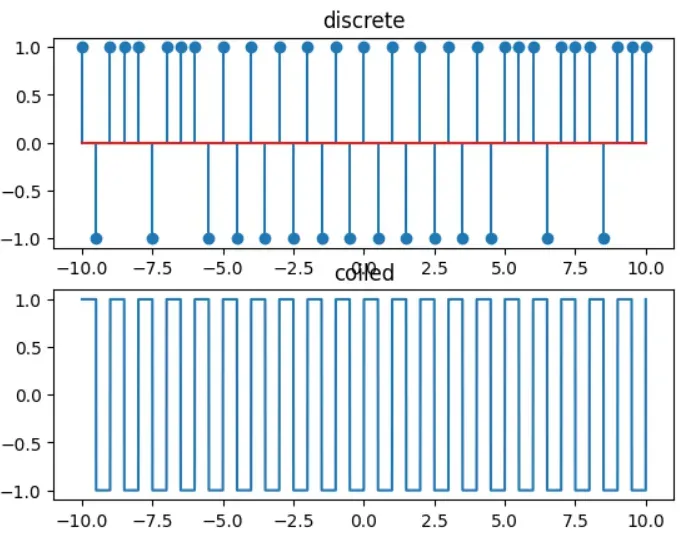
可以看到,上下两图的区别。
27、离散时间系统的冲激和阶跃响应:
import matplotlib.pyplot as plt
import numpy as np
from scipy import signal
a=[1,-0.35,1.5]
b=[1,1]
system=(b,a)
t=np.linspace(0,21,21,dtype=int)
x=np.power(0.5,t)
T,yout,xout=signal.lsim2(system,T=t)
print(T.size,yout.size,xout.size)
fig1=plt.figure()
ax1=fig1.add_subplot(1,2,1)
ax1.stem(t,x)
ax1.set_title('imput Sequence')
ax1.grid(visible=True)
ax2=fig1.add_subplot(1,2,2)
ax2.stem(t,yout)
ax2.set_title('output Sequence')
ax2.grid(visible=True)
plt.show()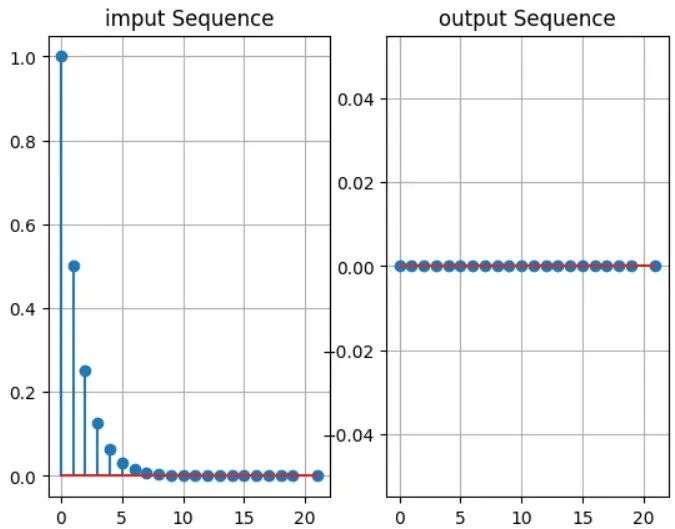
import matplotlib.pyplot as plt
import numpy as np
from scipy import signal
a=[1,6,4]
b=[1,3]
k=np.linspace(0,10,11,dtype=int)
system=signal.dlti(b,a)
T,yout=signal.dstep(system,t=k)
plt.stem(T,np.squeeze(yout))
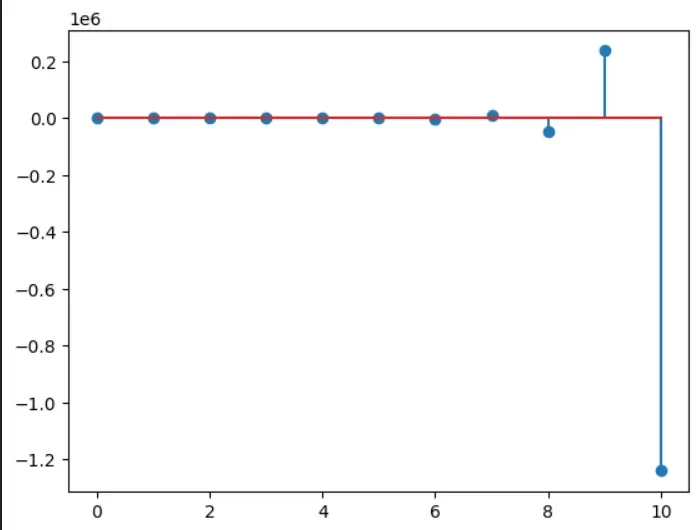
28、卷积和运算,这都不用说啥了,前面都说过了:
#离散时间信号的卷积和运算
import matplotlib.pyplot as plt
import numpy as np
from scipy import signal
def uDt(n):
if n>=0:
y=1
else:
y=0
return y
nx=np.linspace(-1,5,7,dtype=int,endpoint=True)
nh=np.linspace(-2,10,13,dtype=int,endpoint=True)
nx2=nx-4
nh2=nh-9
x=np.array([uDt(i)for i in nx])-np.array([uDt(i)for i in nx2])
h=np.power(0.9,nh)
h1=np.array([uDt(i)for i in nh])-np.array([uDt(i)for i in nh2])
y=np.convolve(h,h1)
ny1=nx[0]+nh[0]
ny=ny1+np.linspace(0,(len(y)),len(y),dtype=int)
fig=plt.figure()
ax1=fig.add_subplot(3,1,1)
ax1.stem(nx,x)
ax1.grid(visible=True)
ax1.set_title('x(n)')
ax1.axis([-4,16,0,1.5])
ax2=fig.add_subplot(3,1,2)
ax2.stem(nh,h)
ax2.grid(visible=True)
ax2.set_title('h(n))')
ax2.axis([-4,16,0,1.5])
ax3=fig.add_subplot(3,1,3)
ax3.stem(ny,y)
ax3.set_title('y(n)')
ax3.grid(visible=True)
ax3.axis([-4,16,0,9])
plt.show()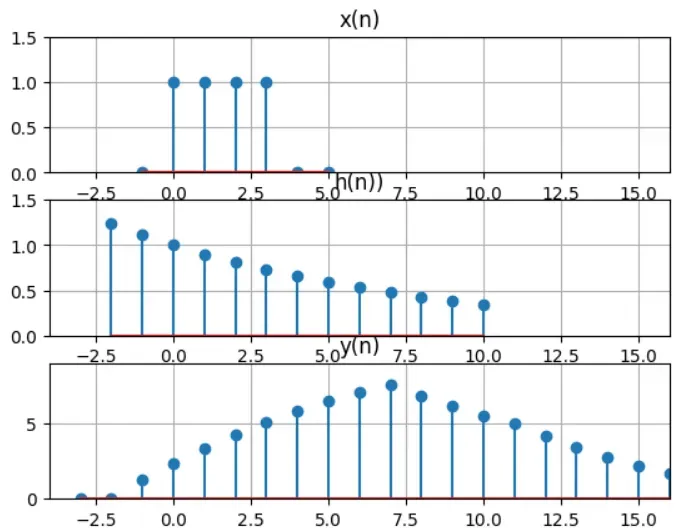
#已知序列卷积求和:
import matplotlib.pyplot as plt
import numpy as np
from scipy import signal
from scipy.stats import pearsonr
x=np.array([1,3,5,7,9,11,13,15,17,19])
y=np.array([1,1,1,1,2,2,2,2,2,2])
z=np.convolve(x,y)
xlength=np.linspace(0,len(x),len(x),dtype=int)
ylength=np.linspace(0,len(y),len(y),dtype=int)
zlength=np.linspace(0,len(z),len(z),dtype=int)
figure=plt.figure()
ax1=figure.add_subplot(3,1,1)
ax1.stem(xlength,x)
ax1.set_title('x(n)')
ax1.grid(visible=True)
ax1.axis([0,len(x),0,20])
ax2=figure.add_subplot(3,1,2)
ax2.stem(ylength,y)
ax2.set_title('y(n)')
ax2.grid(visible=True)
ax2.axis([0,len(y),0,2.2])
ax3=figure.add_subplot(3,1,3)
ax3.stem(zlength,z)
ax3.set_title('z(n)=x(n)*y(n)')
ax3.grid(visible=True)
ax3.axis([0,20,0,max(z)+10])
plt.show()
print(np.corrcoef(x,y))
#这个pearsonr就不用看来,他输出的结果是xy这两个序列的相关系数矩阵,这个在统计学里面会用得到,但现在似乎没有任何用,是我刚开始搞错了
corr_coef, p_value = pearsonr(x, y)
print(corr_coef,p_value)
29、相关序列(自相关、互相关):
这些前面都讲过了,没啥意思的,这里就不再说了
其实,这两天主要就在忙这个,因为,怎么说呢,我是可以看懂matlab的,但是你要让我去用matlab写代码,我是一百万个不情愿,可能是因为1、我的水平还很低级,2、本科的时候学的是面向对象的C++和Python,对面向对象的编程方式比较熟悉,所以我就选择了使用python来学习数字信号处理,Python很强大,而且都是开源的,对于我来说,Python用起来比Matlab顺手的多,当然,这也是个人原因,办公室的几个师兄师姐就觉得matlab比c++和python简单,所以他们Matlab用的多,但是,说白了,编程语言就是个简单工具,最重要的还是算法和思想。
文章出处登录后可见!
